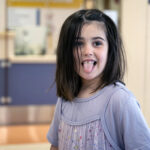Predicting pediatric seizures with a wristband: Study shows what’s possible

The ability to track seizures has a number of potential benefits: It could allow physicians to better determine optimal dosing and timing of medication, as well as enable timely interventions to help prevent impending seizures. Traditionally, electroencephalography (EEG) and electrocorticography have been used to evaluate and forecast seizures.
However, more compact, portable approaches — such as wearable devices — are far more appealing to both physicians and patients for long-term seizures monitoring. One such device, a biosensor wristband developed by Empatica, records autonomic nervous system features, patient movement, and other vital signs and parameters. To learn more, Tobias Loddenkemper, MD, and his colleagues in the Epilepsy Center at Boston Children’s Hospital recently conducted the first human feasibility study on this topic. They sought to evaluate whether data derived solely from these wristbands could accurately predict various types of seizures in pediatric patients. “For patients and their caretakers, the constant worry and uncertainty about presumably random patterns of seizure recurrence are among the most disabling aspects of epilepsy,” says Loddenkemper.
Going deeper with AI
Loddenkemper, the hospital’s director of clinical epilepsy research, and his team in the Loddenkemper Research Laboratory, recruited 69 epilepsy patients who were admitted to Boston Children’s long-term video-EEG monitoring unit between 2015 and 2018. These patients wore the Empatica wristband on either their wrist or ankle while in the unit. Using data collected from the wristbands, the researchers analyzed all types of seizures that occurred, including primary and secondary generalized and focal seizures.
To determine whether the wristbands could accurately predict seizures, they used a technique known as deep learning — a type of artificial intelligence, or AI, that relies on programmable neural networks to perform various classification tasks. Unlike traditional machine learning models, which still require some human guidance, deep learning algorithms use their own artificial neural networks to independently assess the accuracy of their predictions.
Forecasting seizures is feasible
Based on this work, Loddenkemper and his colleagues demonstrated that forecasting seizures is feasible using wristband data. Specifically, they found that the wristbands had a predictability that was better than chance in 43 percent of patients. The ability to predict seizures was independent of the type of seizure and the time of day it occurred, suggesting that this approach could benefit a wide range of epilepsy patients. In addition, the prediction performance of the wristbands increased with additional patients and when they used all sensor modalities — a sign that the larger and richer the data collected, the more accurate the wristbands might be.
“Forecasting seizures with greater precision will enable us to titrate therapies to periods of greatest seizure susceptibility, with potentially fewer side effects at times of lower risk and better therapeutic coverage at times of greater risk,” Loddenkemper explains. Although the potential use of such wristbands is still several years away, this study represents an important first step in harnessing the power of wearables to improve patient care.
The study, led by former Boston Children’s researcher Christian Meisel, MD, PhD, now at the Universitätsmedizin Berlin and Berlin Institute of Health, was published in the October 11, 2020 issue of Epilepsia.
Learn more about the Epilepsy Center and refer a patient.
Related Posts :
-

Parsing the promise of inosine for neurogenic bladder
Spinal cord damage — whether from traumatic injury or conditions such as spina bifida — can have a profound impact on bladder ...
-

“Princess June” reigns supreme over Rasmussen syndrome
What do you call a “girly” 5-year-old who adores dolls and frilly nightgowns? If you’re one of June Pelletier’...
-

Unveiling the hidden impact of moyamoya disease: Brain injury without symptoms
Moyamoya disease — a rare, progressive condition that narrows the brain’s blood vessels — leads to an increased risk of stroke ...
-

Forecasting the future for childhood cancer survivors
Children are much more likely to survive cancer today than 50 years ago. Unfortunately, as adults, many of them develop cardiovascular ...





